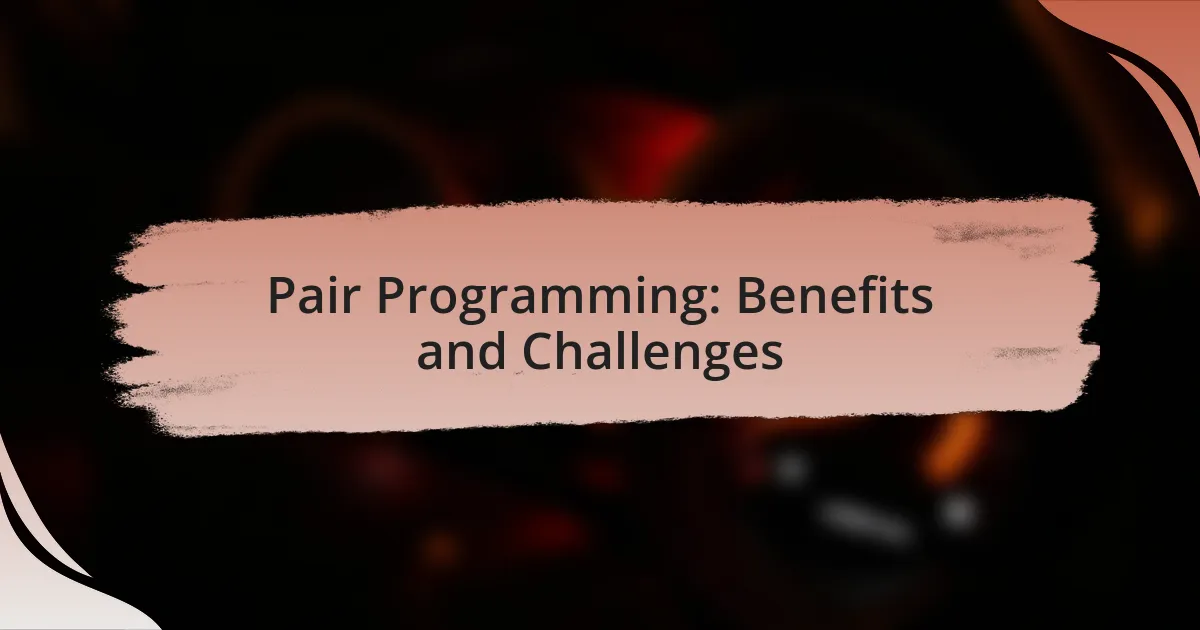Pair programming is a collaborative software development technique where two programmers work together at one workstation, with one acting as the “driver” who writes code and the other as the “navigator” who reviews and provides feedback. This method enhances code quality, increases productivity by up to 15%, and fosters knowledge sharing among team members. The article explores the roles of the driver and navigator, the principles of continuous collaboration and real-time feedback, and the benefits of improved code quality and team morale. Additionally, it addresses challenges such as communication issues and skill disparities, offering strategies for effective implementation and best practices to create a conducive environment for pair programming.

What is Pair Programming?
Pair programming is a software development technique where two programmers work together at one workstation. In this collaborative approach, one programmer, known as the “driver,” writes the code while the other, called the “observer” or “navigator,” reviews each line of code as it is written. This method enhances code quality and facilitates knowledge sharing, as studies have shown that pair programming can lead to fewer defects and improved problem-solving capabilities. For instance, a study by Williams and Kessler in 2000 demonstrated that pair programming can increase productivity by up to 15% compared to solo programming.
How does Pair Programming work?
Pair programming works by having two developers collaborate on the same task at one workstation, where one acts as the “driver” who writes the code, while the other serves as the “observer” or “navigator,” who reviews the work and provides suggestions. This collaborative approach enhances code quality and problem-solving efficiency, as both programmers can share knowledge and catch errors in real-time. Research indicates that pair programming can lead to a 15% increase in productivity and a reduction in defects, as noted in studies conducted by the University of Utah and the University of Nebraska.
What are the roles of the driver and navigator in Pair Programming?
In Pair Programming, the driver is responsible for writing the code and managing the keyboard and mouse, while the navigator reviews the work, provides feedback, and thinks strategically about the overall direction of the task. The driver focuses on the immediate implementation details, ensuring that the code is functional, while the navigator maintains a broader perspective, identifying potential issues and suggesting improvements. This division of roles enhances collaboration and leads to higher quality code, as studies have shown that Pair Programming can reduce defects by up to 15% compared to solo programming.
How do communication and collaboration function in Pair Programming?
Communication and collaboration in Pair Programming function through continuous dialogue and shared responsibility between two programmers working together on the same task. This dynamic fosters real-time feedback, where one programmer, known as the “driver,” writes the code while the other, the “observer,” reviews and suggests improvements. Studies indicate that this method enhances problem-solving capabilities and leads to higher code quality, as evidenced by research from Williams and Kessler, which found that Pair Programming can reduce defects by up to 15%. The collaborative nature of this practice not only improves technical skills but also strengthens interpersonal relationships, creating a more cohesive team environment.
What are the key principles of Pair Programming?
The key principles of Pair Programming include continuous collaboration, role rotation, and real-time feedback. Continuous collaboration ensures that two developers work together at one workstation, enhancing communication and problem-solving. Role rotation involves alternating between the roles of “driver,” who writes code, and “navigator,” who reviews and strategizes, promoting shared knowledge and skill development. Real-time feedback allows immediate identification of errors and improvements, leading to higher code quality and efficiency. These principles are supported by studies indicating that Pair Programming can lead to increased productivity and reduced defect rates in software development.
Why is continuous feedback important in Pair Programming?
Continuous feedback is important in Pair Programming because it enhances collaboration and accelerates learning between partners. This ongoing exchange allows programmers to address issues in real-time, leading to immediate improvements in code quality and problem-solving efficiency. Research indicates that teams practicing continuous feedback can achieve up to 30% faster completion of tasks compared to those that do not, as it fosters a culture of open communication and shared understanding.
How does Pair Programming promote shared ownership of code?
Pair Programming promotes shared ownership of code by facilitating continuous collaboration between two developers, which leads to mutual understanding and accountability for the code produced. In this practice, both participants actively engage in writing, reviewing, and discussing the code, ensuring that knowledge is shared rather than siloed. Research indicates that this collaborative approach enhances code quality and fosters a sense of collective responsibility, as both programmers contribute to and take ownership of the final product. Studies have shown that teams practicing Pair Programming report higher satisfaction and lower defect rates, reinforcing the effectiveness of shared ownership in software development.

What benefits does Pair Programming offer?
Pair Programming offers several benefits, including improved code quality, enhanced collaboration, and increased knowledge sharing. Improved code quality arises from the continuous review process, where one programmer writes code while the other reviews it in real-time, leading to fewer bugs and higher standards. Enhanced collaboration occurs as two developers work closely together, fostering communication and teamwork, which can lead to more innovative solutions. Increased knowledge sharing happens as both programmers learn from each other’s skills and experiences, resulting in a more skilled team overall. Studies have shown that teams practicing Pair Programming can produce code with up to 15% fewer defects compared to solo programming, highlighting its effectiveness in improving software quality.
How does Pair Programming enhance code quality?
Pair Programming enhances code quality by facilitating real-time collaboration between two developers, which leads to immediate feedback and error detection. This collaborative approach allows one developer to write code while the other reviews it simultaneously, reducing the likelihood of bugs and improving overall code structure. Research by Williams and Kessler in their study “All I Really Need to Know About Pair Programming I Learned in Kindergarten” indicates that Pair Programming can lead to a 15-30% increase in code quality due to the continuous review process and shared knowledge.
What impact does Pair Programming have on bug detection?
Pair Programming significantly enhances bug detection by facilitating real-time collaboration between two developers. This collaborative approach allows for immediate feedback and diverse perspectives, which leads to the identification of errors that one developer might overlook. Research indicates that Pair Programming can reduce the number of defects in code by up to 15% compared to solo programming, as noted in a study by Williams and Kessler in “All I Really Need to Know About Pair Programming I Learned in Kindergarten.” This evidence supports the assertion that the interactive nature of Pair Programming improves the overall quality of software by increasing the likelihood of catching bugs early in the development process.
How does Pair Programming facilitate knowledge sharing among team members?
Pair Programming facilitates knowledge sharing among team members by promoting real-time collaboration and communication. In this practice, two programmers work together at one workstation, allowing them to share insights, techniques, and problem-solving approaches instantly. Research indicates that this method enhances collective code ownership and reduces knowledge silos, as both participants actively engage in the coding process, leading to a more comprehensive understanding of the codebase. A study by Williams and Kessler (2000) found that Pair Programming significantly improves the transfer of knowledge between team members, as they discuss their thought processes and decisions, thereby reinforcing learning and retention.
What are the productivity benefits of Pair Programming?
Pair programming significantly enhances productivity by facilitating real-time collaboration and knowledge sharing between two developers. This collaborative approach leads to faster problem-solving, as one programmer can focus on coding while the other reviews and provides immediate feedback, reducing the likelihood of errors. Research conducted by the University of Utah found that pair programming can increase code quality and reduce the time spent on debugging by up to 15%. Additionally, the practice fosters a shared understanding of the codebase, which can lead to more efficient project progression and improved team dynamics.
How does Pair Programming reduce development time?
Pair Programming reduces development time by facilitating real-time collaboration between two developers, which enhances problem-solving efficiency and code quality. This collaborative approach allows for immediate feedback and knowledge sharing, leading to fewer errors and faster debugging. Research indicates that teams practicing Pair Programming can achieve up to 15% faster completion of tasks compared to solo programming, as reported in the study “The Impact of Pair Programming on Software Development” by Williams and Kessler. This efficiency stems from the continuous review process inherent in Pair Programming, which minimizes the time spent on revisions and corrections.
In what ways does Pair Programming improve team morale and collaboration?
Pair Programming enhances team morale and collaboration by fostering direct communication and shared responsibility among team members. This collaborative approach allows developers to work closely together, leading to increased trust and camaraderie. Studies indicate that teams engaged in Pair Programming report higher job satisfaction and a sense of belonging, as they actively participate in problem-solving and decision-making together. Furthermore, the immediate feedback loop created during Pair Programming sessions helps to reduce misunderstandings and conflicts, promoting a more harmonious work environment.

What challenges are associated with Pair Programming?
Pair programming presents several challenges, including communication issues, differing skill levels, and potential for interpersonal conflicts. Communication problems can arise when partners have different styles or levels of clarity, leading to misunderstandings. Differing skill levels can create an imbalance, where one partner may dominate the session, potentially causing frustration for the less experienced individual. Additionally, interpersonal conflicts may emerge due to personality clashes or differing work habits, which can hinder collaboration and productivity. These challenges can impact the effectiveness of pair programming, making it essential for teams to address them proactively.
What are the common obstacles teams face when implementing Pair Programming?
Common obstacles teams face when implementing Pair Programming include resistance to change, mismatched skill levels, and communication issues. Resistance to change often arises from team members who are accustomed to individual work and may feel uncomfortable with the collaborative approach. Mismatched skill levels can lead to frustration, as a more experienced programmer may dominate the session, hindering the learning process for the less experienced partner. Communication issues can stem from differing styles or misunderstandings, which can disrupt the flow of collaboration. These challenges can impede the effectiveness of Pair Programming, making it essential for teams to address them proactively.
How can personality clashes affect the effectiveness of Pair Programming?
Personality clashes can significantly reduce the effectiveness of Pair Programming by creating communication barriers and fostering conflict between partners. When individuals have differing work styles, values, or temperaments, it can lead to misunderstandings and frustration, which detracts from collaborative problem-solving. Research indicates that effective collaboration relies on mutual respect and understanding; thus, personality incompatibility can hinder the flow of ideas and reduce overall productivity. For instance, a study published in the Journal of Software Engineering and Applications found that teams with aligned personalities reported higher satisfaction and performance levels compared to those with significant personality differences.
What are the potential issues with unequal skill levels in pairs?
Unequal skill levels in pairs can lead to several potential issues, including imbalanced contributions and decreased overall productivity. When one partner possesses significantly higher skills, they may dominate the task, resulting in the less skilled partner feeling undervalued and disengaged. This dynamic can hinder effective collaboration, as the less experienced individual may struggle to keep up, leading to frustration and a lack of learning opportunities. Additionally, the more skilled partner may become frustrated with the slower pace, which can create tension and reduce the effectiveness of the pair programming experience. Research indicates that balanced skill levels can enhance communication and learning, while disparities can negatively impact team dynamics and outcomes.
How can teams overcome challenges in Pair Programming?
Teams can overcome challenges in Pair Programming by establishing clear communication and defined roles. Effective communication ensures that both partners share their thoughts and ideas openly, which can reduce misunderstandings and enhance collaboration. Defined roles, such as driver and navigator, help clarify responsibilities, allowing each team member to focus on their specific tasks while still contributing to the overall goal. Research indicates that teams with structured roles and strong communication practices experience improved productivity and satisfaction, as evidenced by a study published in the Journal of Software Engineering and Applications, which found that clear role definitions in Pair Programming led to a 30% increase in task completion rates.
What strategies can be employed to improve collaboration in Pair Programming?
To improve collaboration in Pair Programming, teams can implement strategies such as establishing clear roles, maintaining open communication, and utilizing regular feedback loops. Clear roles, such as defining one person as the “driver” who writes code and the other as the “navigator” who reviews and suggests improvements, can enhance focus and accountability. Open communication fosters a collaborative environment where both participants feel comfortable sharing ideas and concerns, which is crucial for effective problem-solving. Regular feedback loops, such as brief check-ins during the session, allow for adjustments and ensure both partners are aligned on goals and progress. Research indicates that these strategies lead to increased productivity and satisfaction among programmers, as they create a structured yet flexible framework for collaboration.
How can teams ensure balanced participation in Pair Programming sessions?
Teams can ensure balanced participation in Pair Programming sessions by implementing structured roles and regular rotation between the driver and navigator positions. This approach allows both participants to engage actively, as the driver writes code while the navigator reviews and provides feedback. Research indicates that rotating roles every 15 to 30 minutes can enhance collaboration and maintain focus, preventing one participant from dominating the session. Additionally, setting clear expectations for communication and encouraging equal input can further promote balanced participation, as evidenced by studies showing improved outcomes in team dynamics when all members feel empowered to contribute.
What best practices should teams follow for effective Pair Programming?
Effective pair programming requires teams to follow several best practices, including clear communication, defined roles, and regular rotation of partners. Clear communication ensures that both programmers articulate their thoughts and ideas, which enhances collaboration and problem-solving. Defined roles, such as driver and navigator, help maintain focus and efficiency; the driver writes the code while the navigator reviews and provides guidance. Regularly rotating partners fosters diverse perspectives and skills, which can lead to improved code quality and knowledge sharing. Research indicates that teams practicing these best practices experience increased productivity and reduced defects in their code, as highlighted in studies by Williams and Kessler in “Pair Programming Illuminated.”
How can teams set up a conducive environment for Pair Programming?
Teams can set up a conducive environment for Pair Programming by ensuring effective communication, providing the right tools, and fostering a collaborative culture. Effective communication is essential as it allows team members to share ideas and feedback openly, which enhances problem-solving and creativity. Providing the right tools, such as shared coding environments and communication platforms, facilitates seamless collaboration and minimizes technical barriers. Fostering a collaborative culture involves encouraging mutual respect and trust among team members, which has been shown to improve productivity and job satisfaction in software development teams. Research indicates that teams with a strong collaborative culture are 5 times more likely to be high-performing, highlighting the importance of these elements in creating an effective Pair Programming environment.
What tools can enhance the Pair Programming experience?
Tools that can enhance the Pair Programming experience include Visual Studio Live Share, CodeTogether, and Tuple. Visual Studio Live Share allows real-time collaboration within the Visual Studio environment, enabling developers to share their code and debugging sessions seamlessly. CodeTogether supports multiple IDEs and facilitates remote pair programming by allowing participants to code together in real-time, regardless of their development environment. Tuple is designed specifically for remote pair programming, providing high-quality audio and video communication alongside screen sharing, which helps maintain a strong collaborative atmosphere. These tools improve communication, streamline workflows, and foster a more effective coding partnership.

Leave a Reply